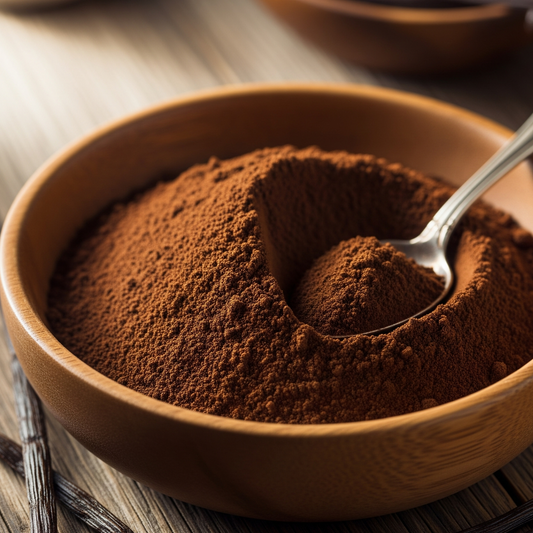
VANILLA BEAN VS EXTRACT: SUBSTITUTION TIPS FOR BAKING
Share
Vanilla, known as the "queen of spices," often associated with comfort and warmth. Whether you're baking a lot of cookies, making a creamy custard, or adding depth to your favorite dessert, vanilla plays a crucial role in enhancing flavors.
Imagine you are in the kitchen and find yourself without a vanilla bean, you may wonder: how much vanilla extract equals one vanilla bean? This question is important for both beginners and experienced bakers alike. In this blog, we are going to explore the relationship between vanilla extract and vanilla beans, helping you make informed choices for your culinary creations.
Understanding Vanilla: The Bean vs. The Extract
Before diving into the substitution ratios, let’s clarify what vanilla beans and vanilla extract are.
Vanilla Beans: These are the pods that come from the vanilla orchid. The vanilla beans are harvested, cured, and dried to develop their rich flavor. Each bean is packed with tiny seeds that release a full-flavored aroma and flavor, making them a desired ingredient in many gourmet recipes.
Vanilla Extract: This is made by soaking vanilla beans in alcohol and water, extracting their flavor and aroma. Vanilla extract is widely used due to its convenience and potency, providing a similar, although not identical flavor to whole vanilla beans.
The Substitution Ratio: Vanilla Extract vs. Vanilla Beans
When it comes to substituting vanilla extract for vanilla beans, the general rule of thumb is:
1 vanilla bean = 1 tablespoon of vanilla extract.
This ratio is helpful for most recipes, ensuring you maintain a rich vanilla flavor without compromising the dish. However, there are nuances to consider.
- Concentration of Flavor
While one tablespoon of vanilla extract may provide a similar flavor profile to one vanilla bean, the potency of the flavor can vary. Pure vanilla extract tends to have a more intense flavor compared to imitation vanilla extract. Therefore, if you're using imitation extract, you might want to increase the quantity to ensure you capture the essence of vanilla in your recipe.
- Type of Recipe
The context of the recipe matters; for instance, in delicate pastries or custards where vanilla is the star ingredient, using whole bulk vanilla beans can upgrade the dish with a more complex flavor profile. On the other hand, for robust recipes like chocolate cake or cookies, vanilla extract often meets requirements.
The Cost Factor: Is It Worth It?
Vanilla beans can be quite pricey, often ranging from $2 to $10 per bean, depending on quality and origin. In contrast, vanilla extract is usually with reasonable pricing and more so, convenient for everyday baking. So, when considering your budget and the frequency of your baking endeavors, think about the following:
- If you bake regularly and enjoy experimenting with recipes, investing in quality vanilla beans might be worthwhile for special occasions.
- For everyday recipes, vanilla extract is a more economical option that still provides fantastic flavor.
Tips for Using Vanilla Beans
If you decide to work with vanilla beans, here’s how to get the most out of them:
- How to Use: To utilize a vanilla bean, split it lengthwise with a sharp knife and scrape out the seeds. Combine the seeds with your other ingredients for maximum flavor.
- Storage: Keep your vanilla beans in an airtight container in a cool, dark place. Proper storage can extend their shelf life significantly.
- Leftover Pods: Don’t throw away the empty pods! They can be added to sugar or salt to infuse flavor, or simmered in milk or cream for future recipes.
Flavor Beyond Baking: Exploring Vanilla Extract and Beans
While vanilla extract and vanilla beans are majorly used in baking, their applications extend to various culinary realms. Here are some creative uses:
- Savory Dishes: A hint of vanilla can elevate sauces, marinades, and even certain meat dishes, adding a unique flavor dimension.
- Beverages: Use vanilla beans or extract in smoothies, lattes, or cocktails to create delightful drinks.
- Homemade Products: Craft your own vanilla-infused sugar, vanilla syrup for coffee, or even homemade vanilla ice cream.
Shop Now: Elevate Your Baking with Our Premium NY Vanilla's Vanilla Beans Selections!
Making the Right Choice for Your Recipe
In the grand scope of baking, the choice between vanilla extract and vanilla beans comes down to the desired and favored flavor intensity, cost, and recipe type. Understanding the substitution ratio of 1 vanilla bean to 1 tablespoon of vanilla extract allows you to navigate your culinary adventures with confidence.
So, the next time you're in the kitchen, remember this guide, and don't hesitate to experiment with both forms of vanilla to find what suits your taste buds best!
What’s your favorite way to use vanilla in your cooking or baking? Share your tips and recipes in the comments below! And don’t forget to pin this guide for easy reference in the future!



